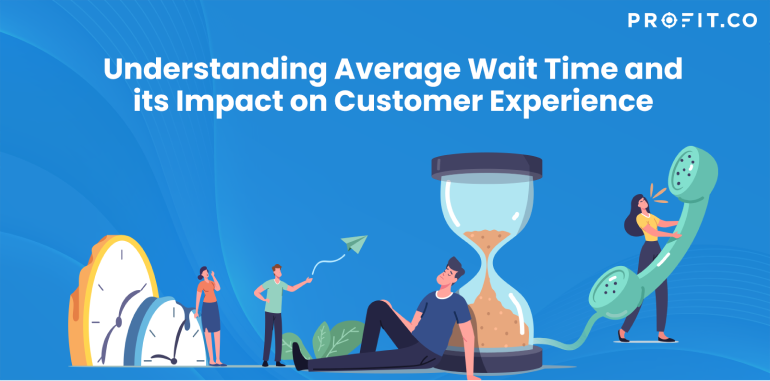Introduction
Customer experience stands as a paramount factor in the triumph of every business. And customers today have exceptionally higher demands for brands that they believe offer smooth, personalized, and omnichannel experiences 24/7. They also insist that the brands allow them to control their own narrative throughout their journey. True to this, Jeff Bezos attributes Amazon’s resounding success to its unwavering commitment to core values centered around customer obsession.
While talking about customer experience, the first and foremost KPI we should focus on is the Average Wait Time (AWT) they experience during interactions with a company. Perhaps the customer is held in the call operation queue, on hold for some kind of check, or waiting for the representatives to finish a task. But we should know that customers value efficiency and promptness, whether waiting for support, a product, or service delivery.
In this blog, we will explore the significance of Average Wait Time (AWT) or Average Speed of Answer (ASA).
Customers don’t measure you on how hard you tried, they measure you on what you deliver.
Definition of Average Wait Time
Average Wait Time (AWT) is a metric that measures the average amount of time a customer spends waiting for service or assistance. AWT is a key performance indicator that helps organizations identify bottlenecks, optimize processes, and enhance customer satisfaction.
Formula for Average Wait Time
The formula calculates the total waiting time of all customers and divides it by the number of customers served.
AWT = Total Wait Time / Number of Customers Served
Example of Average Wait Time
Now that we know the formula let’s consider a popular e-commerce platform that wants to measure its AWT for customer support inquiries. Over a day, they received 100 support calls, and the cumulative wait time was 500 minutes.
AWT = 500 minutes / 100 calls = 5 minutes per call
In this example, the e-commerce platform’s Average Wait Time is 5 minutes, indicating that customers generally wait approximately 5 minutes before reaching a customer support agent.
Average Wait Time (AWT) vs. Average Handle Time (AHT)
AWT calculates the average time a caller spends waiting to be connected to an agent. AHT measures an agent’s average time to resolve a customer’s issue. This includes the agent’s total talk time, hold time, and after-call work tasks.
Understanding these metrics’ differences is essential for call center managers to make informed decisions to improve overall customer experience.
Factors Affecting Average Wait Time
Many factors could impact the Average Wait Time.
Let’s dive into the factors below that could affect Average Wait Time.
- Staffing volume
One of the primary factors affecting AWT is the number of agents available to handle incoming calls. Understaffed call centers often need longer wait times, leading to customer dissatisfaction.
- Call volume
Higher call volumes can lead to longer wait times if the call center needs to be adequately prepared to handle the increased demand.
- Agent efficiency
Agents take longer to handle calls, and customers may experience longer wait times.
- Call prioritization
Customers with urgent issues or higher lifetime value may receive priority treatment.
- Call routing
Suppose calls are not routed efficiently to the appropriate agents.
- Technological constraints
Outdated or inefficient call center technology can hinder agents’ ability to resolve issues quickly.
Strategies to Improve Average Wait Time
Despite the importance of minimizing AWT, many businesses struggle to achieve their desired targets.
Fortunately, there are several strategies that businesses can implement to reduce their AWT and enhance customer experience:
- Optimize call center staffing
Ensuring call centers are adequately staffed can help reduce wait times. This may involve hiring additional agents, adjusting agent schedules to match peak call volume periods, or implementing a more flexible workforce to handle fluctuations in call volume.
- Leverage AI and automation
Implementing AI and automation technologies, such as chatbots or AI conversational apps, can help reduce AWT by handling routine customer inquiries and requests. This frees agents to focus on more complex issues requiring human expertise.
- Implement efficient call routing
Implementing efficient call routing strategies, such as skill-based or priority routing, can ensure customers are quickly connected to the most appropriate agent, reducing wait times.
- Offer self-service options
Providing customers with self-service options, such as an online knowledge base or FAQ section, can help reduce call volume and AWT by allowing customers to find answers to their questions without needing to contact the call center.
- Monitor and analyze call center metrics
Regularly monitoring and analyzing call center metrics, such as AWT, AHT, and call abandonment rates, can help businesses identify areas for improvement and implement targeted strategies to reduce wait times.
Call centers can improve their customer satisfaction capability with the help of OKRs, a goal management platform that allows organizations to track progress and achieve amazing results. Call Center OKRs help shape customer experience with comprehensive steps to implement and optimize call center strategy.
Objective: Reduce average wait time to improve customer satisfaction.
Initiative 1: Achieve an average wait time of less than 3 minutes for customer support inquiries by the end of the quarter.
Initiative 2: Decrease the number of escalated support cases by 20% within the same quarter.
Initiative 3: Increase the first-call resolution rate to 90% by the end of the quarter.
The Importance of Average Wait Time in Customer Experience
The Average Wait Time is a significant indicator of a call center’s quality of customer service. Long wait times can lead to customer frustration, dissatisfaction, and attrition. According to a study, over 60% of customers are willing to wait in a phone queue for less than two minutes, while 13% refuse to accept any hold times. Additionally, nearly one-third of customers will abandon the call and never try calling again if they don’t receive a quick response. This highlights the need for businesses to prioritize reducing their AWT to retain customers and maintain a positive brand image with the competition.
To stay ahead of the competition and start tracking your KPIs!
What is an Acceptable Average Wait Time?
When determining an acceptable AWT, there is no one-size-fits-all answer. However, call center experts often refer to the 80/20 rule, which suggests that contact centers should aim to answer 80% of calls within 20 seconds. This rule may not apply to all industries, as customer expectations may vary depending on the company they are calling.
For example, research conducted by Call Centre Helper discovered that more than 50% of callers hung up after 45 seconds of waiting in a sales contact center. Over half the callers did so in a tech support center after 95 seconds. The key takeaway is that customer expectations and the nature of the call play a significant role in determining what constitutes an acceptable wait time.
FAQs
1. Why is Average Wait Time important?
Average Wait Time is crucial because it directly impacts customer satisfaction. Long wait times can lead to frustration, dissatisfaction, and potential customer churn. Monitoring and optimizing AWT enables businesses to identify areas for improvement, reduce wait times, and enhance the overall customer experience.
2. What factors influence Average Wait Time?
Several factors can affect AWT, including the number of customers, staffing levels, operational efficiency, service complexity, and customer arrival patterns.
3. Can Average Wait Time vary across different industries?
The acceptable AWT can vary depending on the industry and customer expectations. For example, customers anticipate shorter wait times in a fast-food restaurant than in a healthcare facility or a busy customer support call center.
Conclusion
Monitoring and improving the Average Wait Time is critical to delivering exceptional customer service. By tracking AWT, businesses can identify areas of improvement, streamline processes, and enhance customer satisfaction. Organizations can build trust and loyalty and gain a competitive edge in today’s customer-centric market by using OKR examples to reduce wait times and ensure efficient service delivery.

